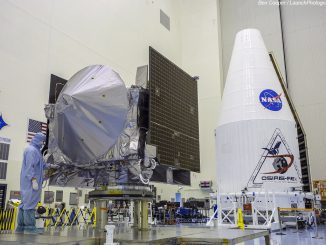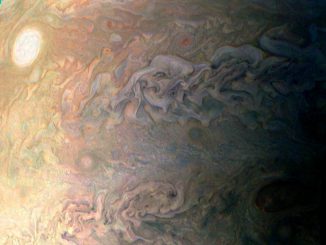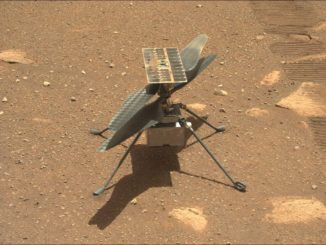
Five days after taking off on a heavy-lift Long March 5 rocket, China’s Chang’e 5 sample return spacecraft entered orbit around the moon Saturday, moving into position for a descent to the lunar surface in a bid to gather specimens and bring them back to Earth.
The Chang’e 5 spacecraft fired its main engine at 1258 GMT (7:58 a.m. EST) for a 17-minute burn to maneuver into an elliptical eight-hour orbit around the moon, according to the China National Space Administration.
The lunar orbit insertion maneuver capped a five-day journey from Earth since Chang’e 5’s launch Nov. 23.
The spacecraft was set to perform additional burns over the weekend to reach a circular 120-mile-high (200-kilometer) orbit around the moon, setting the stage for separation of the mission’s landing module for an automated descent to the lunar surface.
Chinese officials have not disclosed when the Chang’e 5 lander will touch down on the moon, but the landing could happen as soon as Sunday.
Chang’e 5 is attempting to return the first samples from the moon in 44 years. If successful, China would become the third country after the United States and the former Soviet Union to gather rocks from the moon’s surface and bring them back to Earth.
The mission’s lander will target a touchdown near Mons Rümker, a volcanic formation that extends more than 4,000 feet — or about 1,300 meters — above the surrounding lava plains.
Chang’e 5’s landing site is located in the Oceanus Procellarum, or Ocean of Storms, region in the northern hemisphere of the near side of the moon. After landing, Chang’e 5’s surface mission will occur during a two-week window of daylight at the landing site, allowing solar energy to power the spacecraft.
Chang’e 5 will extract up to 4.4 pounds, or 2 kilograms, of material from a depth of up to 6.6 feet, or 2 meters, below the surface. Then the specimens will launch back into lunar orbit aboard a small rocket, rendezvous with a return craft, and head for Earth.
The return carrier will re-enter the atmosphere at some 25,000 mph, or 40,000 kilometers per hour, significantly faster than a re-enter from low Earth orbit. The capsule will will land around Dec. 15 in China’s Inner Mongolia region, where teams will retrieve the moon specimens and transport the material to a lab for analysis.

Clive Neal, a lunar scientist at the University of Notre Dame, said China has proven it can land on the moon with previous missions.
“But then they have to collect the sample,” Neal said in an interview shortly after Chang’e 5’s launch. “The interesting thing is they launch from the moon, get into lunar orbit, and then rendezvous with the Earth re-entry vehicle that will bring that sample back to Earth safely and uncompromised. When the Soviets did it in 1976, the last time, it was direct to Earth. They launched from the moon and came straight back to Earth. This one has an extra step in there, which has to go well in order for the sample to actually make it back.
“But given the capability they’ve demonstrated with doing things for the first time, such as the far side landing and roving, I expect things to be successful, and hope they are,” Neal said in an interview with Spaceflight Now.
The sample return mission, if successful, will mark the first time lunar material has been returned to Earth since 1976, when the Soviet Union’s robotic Luna 24 mission brought back around 170 grams, or 6 ounces, of specimens from the lunar surface.
Nine missions have returned moon samples to Earth, including NASA’s six Apollo missions with astronauts, and three robotic Luna spacecraft launched by the Soviet Union. NASA’s Apollo missions brought back 842 pounds (382 kilograms) of rocks from the moon.
There is evidence that rocks in Chang’e 5’s landing zone are much younger than those returned by the Apollo astronauts. Those specimens are some 3.5 billion years old, created during a period of active volcanism in the first billion years of the moon’s existence.
Lava plains to the east of Mons Rümker appear to be less battered by asteroid impacts, suggesting rocks there could be less than 2 billion years old. But models of the moon’s evolution suggest its internal heating should have diminished by that time, rendering volcanoes extinct, Neal said.
“It will be exciting to look at the age of these samples coming back and also the actual compositions of them,” Neal said.
Before Chang’e 5, China has successfully dispatched four robotic explorers to the moon, beginning with the Chang’e 1 and Chang’e 2 orbiters in 2007 and 2010. In 2013, China landed the Chang’e 3 mission on the moon with a mobile rover that drove across the lunar surface.
China’s most challenging lunar mission to date was Chang’e 4, which accomplished the first-ever soft landing on the far side of the moon in January 2019. Chang’e 4’s rover continues operating, sending back imagery and scientific data through a dedicated relay satellite China placed in a position beyond far side of the moon to transmit signals between Earth and the Chang’e 4 spacecraft.
The Chang’e missions are named for a moon goddess in Chinese folklore.
Email the author.
Follow Stephen Clark on Twitter: @StephenClark1.



